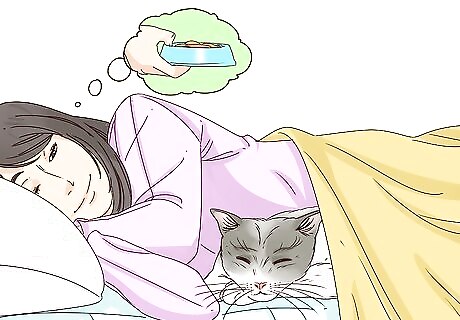
views
Keep your cat active during the day.

An active cat during the day leads to a sleepy cat at night. Enrich your cat’s life with play sessions in the morning and when you get home, or take a short walk around the block on a cat leash. Aim for sessions that last around 5-15 minutes, and about 30-40 minutes total during the day. In addition to this all-important bonding time, leave out some toys that your cat enjoys playing with on its own. Cats usually really like playing with small, fast-moving toys that replicate their instinctual hunting behaviors. When a cat decides an activity session is over, it’s over! Wait until it seems interested and try again later. An active cat is still going to nap a lot during the day—it’s normal for cats to sleep for 16 out of every 24 hours!
Do a play session before the bedtime feeding.

Establish a routine of 10 minutes of evening play with your cat.. This will help tire out your cat and, if you stick to a consistent schedule, teach it that this signals bedtime. Start with energetic play, but wind down with slower, calmer movements for the last few minutes. Have a hyper kitten? Redirect its attention to a treat when it's time to stop roughhousing. Older cats still benefit from play, even if they need convincing. Use soft, slow-moving toys.
Feed your cat right before bedtime.

A hearty meal makes you sleepy, and the same is true for your cat! Most cats need to take a snooze after a big meal, so encourage sleep by feeding your cat its biggest meal of the day right before you both go to bed. Create a routine so this feeding happens at basically the same time each night. This helps to signal to your cat that bedtime always follows evening mealtime. While you should feed your cat right before bedtime, don’t feed it first thing in the morning. Otherwise, your cat will start nudging you to wake up earlier and earlier in order to get its breakfast! Do several parts of your normal morning routine, then feed your cat—perhaps at the same time that you eat breakfast.
Put a cat perch near your bed.

Encourage your cat to watch as you prepare your bed for sleeping. Cats enjoy cozy, high perches where they can observe the room. Put a few treats on the perch, if needed, to encourage your cat to hang out there while you complete your final preparations for bedtime. This gets your cat comfortable with your nightly routine, one short step away from joining you in bed. Your cat may end up preferring to sleep on its perch instead of in bed with you. Consider this to be at least a partial victory and set up your feline friend’s cat bed on the perch!
Make your bed inviting to your cat.

Let your cat explore the bed and decide for itself if it likes it. Use your knowledge of your cat’s likes and dislikes to make the bed a welcoming place. For instance, use catnip if your cat usually responds to it. Or, if catnip isn’t your pet’s thing but covered settings are, set up a “cat cave” at the foot of the bed. Your goal is to encourage your cat to choose to go to your bed and build positive associations with it. Your cat might like the feel of a soft, fluffy blanket, or prefer a less fluffy quilt instead. Making minor adjustments to the room environment might help as well. See if making the room a little darker and cooler at night, or maybe a little lighter and warmer, does the trick. Don’t make big changes that affect your own sleeping comfort, though. In case you haven’t figured it out by now, cats don’t like to be bossed around! You can’t force your cat to like your bed and want to sleep there. But you can make your bed more inviting so that your cat is more likely to choose to sleep there.
Reward your cat for joining you in bed.

Hide treats that your cat can find without openly disturbing you. Your cat might be hesitant to fall asleep in the bed but more willing to explore it. In this case, try rewarding your cat with treats for joining you in bed and hanging out there. Hide treats, for instance, under a pillow and in your pajama pocket for your cat to find on its own. Pretend to stay asleep when it finds the treats so you don’t reward your cat for waking you up. Once your feline pal starts joining you in bed consistently, gradually taper off the number of treats you hide for it. Cats respond really well to positive reinforcement like this. Consistency is key early on. Make sure your cat can get a treat every night. (Just don't give extras if it paws or meows, or you'll never get any sleep!) Once it's in the habit, give your cat a treat 3 days out of 4. Gradually reduce the treats to once every other night, then once every 3 nights, and so on, until the reward is no longer needed.
Try fresh sheets or “you-scented” sheets.

Cats are picky about their bedding, so use trial-and-error. Some cats are clean freaks that are much more likely to sleep on freshly-washed bedding. Others love the smell of their owner and would much prefer that you lay the sweatshirt you wore yesterday on the bed. Still others might prefer that you move the blanket from their cat bed to your bed in the evening. Some cats like to choose a single sleep setting for 2 or 3 months and then decide to switch things up. In this case, you may find it helpful to switch out your comforter seasonally in order to change the sleep environment slightly.
Ignore attention-seeking behavior.

Don’t reward your cat for keeping you awake. Once you shut off the lights to indicate it’s time to sleep, close your eyes and—as much as possible—ignore whatever your cat is doing throughout the night. Even if your cat marches, nuzzles, swats, or meows, don’t talk to it, play with it, or react in any way. These responses teach your cat that waking you up—or preventing you from sleeping—is a successful way to get your attention. This is especially important in the morning, when your cat will probably try to wake you up to feed it. Hold fast, wake up at your planned time, and do other parts of your routine before feeding your cat. You may need to put a pillow over your ears through a few meow-filled mornings, but most cats will lose the habit if you stay firm.
Correct, don’t punish, bad behavior.

Manage behavior you can’t ignore with controlled correction. If your cat starts biting or clawing, or is endlessly howling or batting at your face, ignoring it just won’t do. Reinforce your status as the “boss” by correcting your cat after such behavior. But never jump from calm correction to angry punishment, such as screaming at or smacking your cat. Cats don’t learn anything beneficial from that type of behavior on your part. Correction might mean sending your cat to the other side of the bed by saying “no” and moving it away from you. Or, you might have to send your cat to a carrier, sleeping box, or cat bed placed in the corner of the room. Repeat your correction for as long as your cat repeats its bad behavior.
Give a restless kitten more exercise and comfort.

Kittens can need extra help to calm down and fall asleep. Kittens are little bundles of energy that need to get worn out and feel extra cozy in order to sleep well. Luckily, most of the same techniques that work for adult cats work for kittens as well—you may just have to take things up another notch! In addition, keep the following in mind: If your kitten races around during the night, it needs more play during the day. Playing with you is great, and—if possible—playing with other kittens is even better. If your new kitten meows and doesn't want to cuddle you, wrap a ticking clock and a slightly hot water bottle in a blanket and place it in your intended cuddling spot. The ticking resembles a heartbeat and the warmth replicates the feeling a kitten gets from cuddling up with its mother.
Adapt as an older cat’s health declines.

Older cats need special accommodations to sleep comfortably. Most older cats (age 10+) have some degree of mental or sensory decline that affects their sleeping patterns. If restless, noisy, or otherwise problematic night time behavior appears suddenly, especially in a cat you’ve lived with for a long time, contact your vet to rule out medical issues. Otherwise, try a few helpful tricks for helping out your older cat: If your older cat has increasing trouble getting into and out of your bed, set up some cat stairs—using a step stool, stacked boxes, etc.—to make things easier. If your older cat becomes more restless at night, expand on your regular daytime exercise schedule to help tire it out. Opt for shorter but more frequent play sessions that better suit an older cat. If your older cat meows plaintively or soils the floor, it might be getting lost or scared due to deteriorating eyesight. Install night lights between your bed and the litter box.



















Comments
0 comment